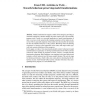Free Online Productivity Tools
i2Speak
i2Symbol
i2OCR
iTex2Img
iWeb2Print
iWeb2Shot
i2Type
iPdf2Split
iPdf2Merge
i2Bopomofo
i2Arabic
i2Style
i2Image
i2PDF
iLatex2Rtf
Sci2ools
ECMDAFA
2008
Springer
2008
Springer
From UML Activities to TAAL - Towards Behaviour-Preserving Model Transformations
Model transformations support a model-driven design by providing an c translation of abstract models into more concrete ones, and eventually program code. Crucial to a successful application of model transformations is their correctness, in the sense that the meaning (semantics) of the models is preserved. This is especially important if the models not only describe the structure but also the intended behaviour of the systems. Reasoning about and showing correctness is, however, often impossible as the source and target models typically lack a precise definition of their semantics. In this paper, we take a first step towards provably correct behavioural model transformations. In particular, we develop transformations from UML Activities (which are visual models) to programs in TAAL, which is a textual Java-like programming language. Both languages come equipped with formal behavioural semantics, which, moreover, have the same semantic domain. This sets the stage for showing correctness...
Behavioural Model Transformations | ECMDAFA 2008 | Formal Behavioural Semantics | Hardware | Model Transformations |
| Added | 19 Oct 2010 |
| Updated | 19 Oct 2010 |
| Type | Conference |
| Year | 2008 |
| Where | ECMDAFA |
| Authors | Gregor Engels, Anneke Kleppe, Arend Rensink, Maria Semenyak, Christian Soltenborn, Heike Wehrheim |
Comments (0)

